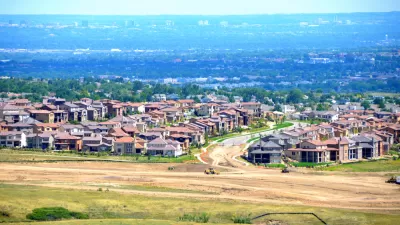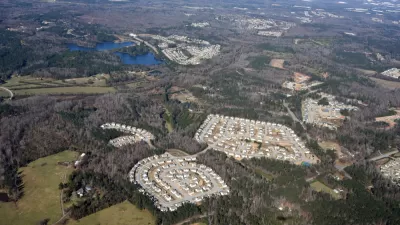Retrofitting suburbia may be a challenge in a small town with high birth rates.

Last week, I visited a very unusual college town: Lakewood, New Jersey, roughly halfway between New York and Philadelphia. Lakewood is dominated by yeshivot- academies for the study of the Talmud and other Jewish sacred texts. Most students at these academies are college-age Orthodox Jews (in particular, "yeshivish" Jews who tend to be more ritually strict than modern Orthodox Jews and less so than Hasidic Jews). Because the yeshivot have grown rapidly over the decades and the students marry early and rarely practice birth control, Lakewood is growing rapidly: its population has doubled since 1990.
Normally, growing cities full of young people have prosperous downtowns. But downtown Lakewood is just so-so: certainly stronger than many Sun Belt downtowns, but far less busy than many college towns. The downtown has a small grocery store and a smattering of Jewish-oriented businesses; many of the larger businesses have migrated to the edge of town. Compared to the Orthodox neighborhoods of Brooklyn, downtown Lakewood seems lackluster. What’s wrong here?
I talked to a few locals, and got this story: because Lakewood is not close to any big city, it has minimal public transit, and the transit that exists is designed to serve long distance commuters rather than local residents. So when the town grew, the number of cars grew, making driving and parking difficult. Much of the downtown's retail moved to suburbia where parking was easier, and many new jobs are in suburban office parks.
However, this story misses a key detail; the blocks surrounding downtown are already dominated by parking. In fact, the downtown seems to have far more "homes" for parking than for people—and yet the parking still is not convenient for many. So in Lakewood, as in many other downtowns, the attempt to build a parking-oriented downtown is not working.
So my instinctive response would be to replace the parking lots with apartment buildings and offices; if more people lived and worked within a block or two of downtown, the retail stores would have more shops, and whatever the town lost from fewer parking spaces would be made up for by increased pedestrian retail traffic.
Having said that, Lakewood is unique in one respect. A typical college town has lots of single young adults who can live in small apartments, which in turn means that a developer can cheaply build lots of apartments. But in Lakewood, 61 percent of rental households have children under 18. (By contrast, in Charlottesville, Virginia, home of the University of Virginia, only 21 percent of rental households have children under 18.) So the "retrofitting suburbia" playbook may have to be modified to fit this reality, perhaps by building apartments with more bedrooms.
In addition, some public transit to and from the edge of town might reduce demand for driving. About 13 percent of Lakewood households have no car, somewhat more than in most suburbs. And 40 percent of households have just one car—not an abnormally high number by national standards, but high for suburbia. By contrast, in nearby Howell, only 25 percent of households have fewer than two cars. So there may be latent demand for better bus service—and if the city grows up instead of out, there may eventually be enough of a population base to justify some sort of light rail.

Study: Maui’s Plan to Convert Vacation Rentals to Long-Term Housing Could Cause Nearly $1 Billion Economic Loss
The plan would reduce visitor accommodation by 25,% resulting in 1,900 jobs lost.

North Texas Transit Leaders Tout Benefits of TOD for Growing Region
At a summit focused on transit-oriented development, policymakers discussed how North Texas’ expanded light rail system can serve as a tool for economic growth.

Using Old Oil and Gas Wells for Green Energy Storage
Penn State researchers have found that repurposing abandoned oil and gas wells for geothermal-assisted compressed-air energy storage can boost efficiency, reduce environmental risks, and support clean energy and job transitions.

Private Donations Propel Early Restoration of Palisades Playground
Los Angeles has secured over $1.3 million in private funding to restore the Pacific Palisades playground months ahead of schedule, creating a modern, accessible space that supports community healing after recent wildfires.

From Blight to Benefit: Early Results From California’s Equitable Cleanup Program
The Equitable Community Revitalization Grant (ECRG) program is reshaping brownfield redevelopment by prioritizing projects in low-income and environmental justice communities, emphasizing equity, transparency, and community benefits.

Planting Relief: Tackling Las Vegas Heat One Tree at a Time
Nevada Plants, a Las Vegas-based nonprofit, is combating the city’s extreme urban heat by giving away trees to residents in underserved neighborhoods, promoting shade, sustainability, and community health.
Urban Design for Planners 1: Software Tools
This six-course series explores essential urban design concepts using open source software and equips planners with the tools they need to participate fully in the urban design process.
Planning for Universal Design
Learn the tools for implementing Universal Design in planning regulations.
Ascent Environmental
Borough of Carlisle
Institute for Housing and Urban Development Studies (IHS)
City of Grandview
Harvard GSD Executive Education
Toledo-Lucas County Plan Commissions
Salt Lake City
NYU Wagner Graduate School of Public Service






























